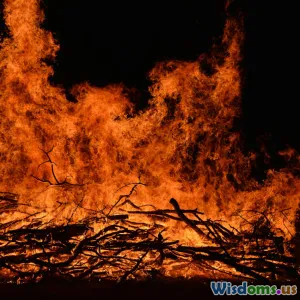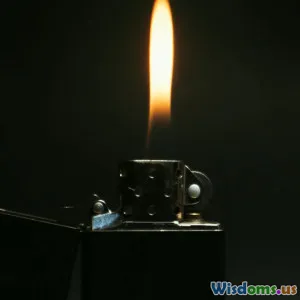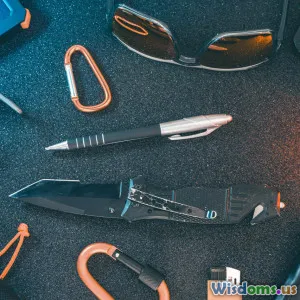
Fire Safety Techniques for Campers
8 min read Master essential fire safety techniques to stay safe and enjoy your camping adventure without hazards. (0 Reviews)
Fire Safety Techniques for Campers: Essential Skills to Keep Your Adventure Safe
Introduction
When the sun sets and the stars light up the sky, few things offer campers as much comfort as a warm, crackling fire. A campfire is not just a source of heat and light; it embodies the spirit of outdoor adventure and survival. However, with great fire comes great responsibility. Uncontrolled fires cause thousands of forest fires each year, endangering wildlife, destroying ecosystems, and jeopardizing human lives. Understanding fire safety techniques for campers is crucial—not only to protect natural habitats but also to ensure your own safety and that of your group. This article delves into practical fire safety strategies, backed by real-world insights and essential tips that every camper should know.
Understanding the Risks: Why Fire Safety Matters
It’s estimated that 85% of wildfires in the United States are human-caused, many originating from improperly managed campfires [National Interagency Fire Center, 2023]. Fires can spread rapidly through parched forests, brush, and grasslands, often exacerbated by wind and dry conditions. Beyond environmental destruction, campfire accidents lead to injuries, property damage, and costly firefighting efforts.
In 2022, an analysis by the U.S. Forest Service showed that campers' negligence accounted for a significant number of fire-related incidents in national parks. This underscores the importance of preemptive knowledge and active fire management.
Choosing the Right Spot: Location, Location, Location
Fire safety begins before you strike the match. Selecting the right location is pivotal.
Clear the Area
Choose a site clear of overhanging branches, dry leaves, pine needles, and other combustible materials. Ideally, you want a spot with a natural firebreak such as rocky soil, sand, or bare ground.
Use Existing Fire Rings
Whenever possible, use established fire rings or pits. These have been placed by park authorities or prior campers to contain fire and reduce impact on the environment.
Respect Local Regulations
Before lighting any fire, check local fire advisories—many forests impose seasonal bans due to wildfire risk. Failing to comply can lead to hefty fines or worse.
Building a Fire Safely: Techniques and Best Practices
Creating a safe fire means understanding how to build and maintain it responsibly.
The Three-Point Building Method
Start with tinder (dry leaves, bark, or commercial fire starters), add kindling (small sticks), then gradually larger pieces of wood. Stack them loosely to allow airflow but keep the fire contained.
Size Matters
Keep your campfire small—less than 3 feet in diameter and flame height under 2 feet. This size is easier to control and extinguish.
Wind Awareness
Construct your fire shielded from strong winds by using natural windbreaks or digging a shallow pit, but avoid over-enclosed setups that restrict oxygen.
How to Extinguish Your Fire: Never Leave a Fire Smoldering
One of the most critical safety steps is fully putting out your fire before sleeping or leaving the site.
Step 1: Let the fire burn down
Allow the wood to burn to ash if possible. This wastes less water during extinguishing.
Step 2: Douse with water
Pour water onto the fire site, ensuring all embers are soaked. Use enough water to fill the pit, not just a sprinkle.
Step 3: Stir the ashes
Use a stick or shovel to turn the ashes, mixing unburned fuel with water to cool everything.
Step 4: Feel for heat
With your hand safely near (without contact), check for warmth. If you feel heat, add more water and stir until completely cool.
This process prevents accidental reignition, forest fire outbreaks, and injuries.
Wildfire Awareness: Prevention and Response
Wildfires have devastating impacts, and campers play a key role in prevention.
Carry Fire-Resistant Gear
When camping in fire-prone areas, bring a portable fire extinguisher, fire blanket, and additional water supplies.
Use Alternatives
Consider using camp stoves instead of open fires. Portable gas stoves are efficient and minimize fire risks.
Report Suspicious Fires
If you spot uncontained fires or smoke, report immediately to the local ranger station or fire department.
Lightning and Fire
Remember, lightning is a natural fire source. Watch the weather for storms that could increase fire risk.
Real-World Example: The 2020 California Wildfires
In 2020, California experienced its largest wildfire season on record, burning over 4 million acres. Investigations revealed many fires were linked to human activity, including campfires left unattended or improperly extinguished. Officers emphasized the critical need for stringent fire safety practices among campers and hikers, reiterating that a small spark can become a disaster in dry conditions.
Campfire Safety Tips Summary
- Always clear fire zones of combustible debris
- Use existing fire pits when possible
- Keep fires small and manageable
- Never leave fires unattended
- Extinguish fully using water and stirring
- Comply with local fire regulations
- Be prepared with fire safety equipment
Conclusion
A campfire enriches the outdoor experience but brings inherent risks that can no longer be overlooked given the escalating wildfire threats worldwide. By mastering and practicing these fire safety techniques, campers not only protect precious nature and their own safety but also contribute to a culture of responsible outdoor stewardship. Remember, your most memorable moments in the wilderness should be filled with stories by the fire—not disasters caused by one. Stay safe, stay vigilant, and enjoy your adventure responsibly.
References
- National Interagency Fire Center. (2023). Wildfire Statistics. Retrieved from https://www.nifc.gov
- U.S. Forest Service. (2022). Forest Fire Reports. Retrieved from https://www.fs.usda.gov
- California Department of Forestry and Fire Protection. (2020). Wildfire Prevention Report.
Your knowledge of fire safety can be the difference between a memorable camping trip and a tragic incident. Share these tips with fellow adventurers and help protect our natural playgrounds.
Rate the Post
User Reviews
Popular Posts





















